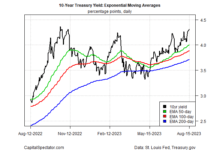U.S. Bonds Oversold on Monthly Technicals, Yield Curve Could Support Rebound
AGG
+0.21%
Add to/Remove from Watchlist
Add to Watchlist
Add Position
Position added successfully to:
Please name your holdings portfolio
Type:
BUY
SELL
Date:
Amount:
Price
Point Value:
Leverage:
1:1
1:10
1:25
1:50
1:100
1:200
1:400
1:500
1:1000
Commission:
Create New Watchlist
Create
Create a new holdings portfolio
Add
Create
+ Add another position
Close
TLT
-0.25%
Add to/Remove from Watchlist
Add to Watchlist
Add Position
Position added successfully to:
Please name your holdings portfolio
Type:
BUY
SELL
Date:
Amount:
Price
Point Value:
Leverage:
1:1
1:10
1:25
1:50
1:100
1:200
1:400
1:500
1:1000
Commission:
Create New Watchlist
Create
Create a new holdings portfolio
Add
Create
+ Add another position
Close
 TLT Monthly Chart
TLT Monthly Chart
Both the iShares Core U.S. Aggregate Bond ETF (NYSE:AGG) and the iShares 20+ Year Treasury Bond ETF (NASDAQ:TLT) have reached “oversold” status on the monthly charts, which normally doesn’t happen without some severe pain inflicted to get there.
Click on the above charts and expand the graph so that you can get a better look.
 AGG Monthly Chart
AGG Monthly Chart
After doing that, look at the bottom panel, which denotes overbought/oversold conditions, and then note how the gray and red lines coalesce at the bottom.
Both reflect heavily oversold conditions.
That being said – if there is a potential secular shift in interest rates, like in the 1970s or 2008, the technicals can get oversold quickly – even on the monthly chart – even though the underlying security can continue declining.
For example, the Nasdaq’s 80% drop between March 2000 and October 2002 shows that it was oversold on a monthly basis by the end of 2001, helped undoubtedly by 9/11 and what followed. Still, the actual Nasdaq Composite didn’t start to stabilize until late 2002, and the rally didn’t start until March 2003.
Conclusion
Small amounts of TLT and the AGG were bought this week with the Jay Powell testimony, but next week’s CPI data and the jobs data may still not be weak enough to drive a rally in the long end of the Treasury curve. It’s likely investors will need to see the Fed / FOMC start to say that rate hikes are ending and the Fed will give the tightening time to work.
There is room for longer-duration fixed-income instruments, but why anticipate the lower inflation and weaker economic data conditions that will be needed to drive outperformance in the longer end of the Treasury yield curve? Let’s just wait on it.
The battle between the inflationistas and the “recessionistas” has been ongoing for 15 months or longer. I can’t help thinking about Jamie Dimon’s comments in early 2022 about the “economic hurricane” that was due to begin shortly and yet never did.
The inflation hawks have had it more right than the recession hawks.
Not one (think of Bill Burr, the comedian) i.e., not one (hysterically) economist, strategist, pundit, guru, CNBC visionary has called for a US economy that can grow at a 2% GDP rate and see inflation “disinflate” or decline.
The Cassandras are positioned at the hysterical ends of the spectrum, which gets the media’s attention.
Given the bond market action, the US stock market has held up remarkably well. But we also have to assume that might not last either.




